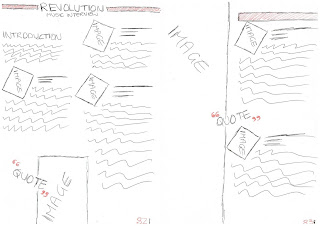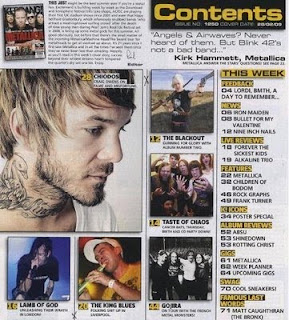In what ways does your media product use and/or challenge the typical conventions of a magazine? To ensure that my magazine is recognised as being of the alternitave/rock genre by the target audience I have followed some typical conventions, this also ensures it is appealing to them. To also ensure that my magazine stands out and has a uniqueness I have done things out of the ordinary challenging conventions for example, advertising the website on the front cover. To better show how each page of my media product follows or challenges conventions I have made presentations using prezi.
In which ways does your media product represent a particular social group?
My magazine is aimed the alternative/indie rock culture, people who like to be unique and have quirky styles and listen to heavier music that wouldn't be classed as mainstream or "normal". Typically the style of people of this culture consists of darker colours, strange combinations of clothes perhaps styles no longer in fashion such as 80's and 90's fashion, dark makeup and quirky haircuts and haircolours.
This can be seen in these photos of the The Japanese Voyeurs and Paramore, who are popular within this culture.
Girls within social group culture look up to female artists within this genre as they are succesful females who got to where they are based on talent alone and aren't afraid to have a unique style and ideas and opinions rather than falling into passive femininity relying on their looks and sex appeal to make them money, and the boys of this social group often find this an attractive quality within girls.
I feel my product represents this social group well as the magazine features articles about the artists that would appeal to this social group and they would be able to relate to my fictonal artist as in the images used I am wearing unusual clothes in darker shades, have one side of my hair shaved and a neon pink fringe and peircings. My artist is also represented as an independant, quirky character who got succesful because of her talent and hardwork, in the interview.
What kind of media institution would distribute your product and why?To find out what media institution would be most likley distribute my media product I researched which institution distributed a magazine from the same genre as mine, Kerrang Magazine.
What kind of media institution would distribute your product and why?To find out what media institution would be most likley distribute my media product I researched which institution distributed a magazine from the same genre as mine, Kerrang Magazine.
As Kerrang magazine is aimed at the same target audience and social group as my magazine. I feel Bauer Media Group would be most likely to distribute my magazine. They would best know how to market it, where to sell it and how to make it gain popularity amongst the target audience. Kerrang is a very successful well known brand and Bauer Media Group have 136 years experience operating in 15 countries with a worldwide distribution figure of 38 million magazines a week.
Ways of distributing my magazine and brand other than the traditional magazine to make it more accessible to my target audience could include it on line on a website, as a downloadable file, and as an app to; IPhones, IPads and Android. It would also be beneficial to my magazine to advertise on music channels of the same genre, advertise at and sponsor gigs of artists from this genre and within schools/colleges.
Who would you define as the target audience for your product?
I had a basic idea of who my target audience would be when I picked this particular genre for my magazine. To better understand my target audience, how would be best to aim my magazine at the social group and find out how popular this genre was I created a questionnaire on Google docs and asked people to fill it out via a social networking site, these were the results of the responses I got.
I then picked one person who enjoyed listening to the indie/rock genre of music and purchased and read music magazine similar to mine.
The person I chose was Cally, as can seen in the photo above. Cally is 17 and is a full time student at sixth form. I asked Cally some questions to better understand my target audience.
Her hobbies were socialising with friends, listening to music and attending gigs; both high profile and underground local bands. She listened to a range of music mainly from the indie/rock sub genres including alternitave, grime-core, pop punk and post hardcore. She described her style as whatever she liked, rather than following trends she wears clothes and outfits that appeal to her and liked to find unique things that not many other people would be wearing.
After my research I was able to conclude that my target audience would consist of both males and females, ranging from the ages of 15-25 and would fall into an alternative social group away from mainstream culture.
How did you ensure to attract and address your audience through your product?
Once I'd researched my target audience and had a better understanding of their lives and things they liked I had a better idea of how to best aim my product at them.
What have you learned about new technology and software during the process of constructing your magazine?
I used a variety of technology and software during the process of constructing my magazine, some I had existing knowledge of, some I learned new skills and some completely new to me.
The main technology used during the process of construction was a digital camera and a laptop/computer. Both of these things I had existing knowledge of how to work and how to achieve the best results from them.
The two main pieces of software used in the construction were Photoshop to edit images and construct my magazine pages and Blogger to upload all my research and work.
I had used Photoshop before but had very basic knowledge of it and the variety of tools and effects available on the software. Using online tutorials and asking for advice from peers I managed to make the most of the software, produce quality pieces of work and learn new skills.
I had never used Blogger before but it was pretty easy to pick up and I grasped how to use it to best advantage within about 20 minutes. It is very similar to a blogsite called Tumblr which I use to run a blog in my spare time.
Other pieces of software I used which were totally new to me were Google Docs, an online application that allows you to create questionnaires and surveys, collect data in a spreadsheet and present it how you wish and Prezi, online software that allows you to make interactive presentations. I found the software easy to use as the websites had interactive tutorials and we were shown how to use it. I feel I have learned a lot of useful skills from using these new software programs that will come in handy in other subjects and areas of life.
In what ways do you feel you have progressed from the preliminarary task to your final product?
How do you feel about your overall product?
Overall I am very pleased with my product, I feel it looks proffesional and is easily recognisable as a music magazine of the rock genre. It looks similar in comparison with existing music magazines of this genre such as Kerrang and NME and I feel I have used and challenged conventions in a positive way achieving my desired look. I used the knowledge I gained from my audience research whilst creating my magazine to ensure it was being aimed at my target audience and appealing to them.
What have you learned from this experience that may help you were to create a similar product in the future?
If I were to create a magazine again in the future I have learned a number of things and gained various skills from this experience which would aid me in this.
The first thing to do would be audience research to ensure you know what your magazine should look like and feature in order to appeal to the right people, no matter how good the production of a product is if it isn't aimed at the audience correctly its useless.
I have gained a lot of knowledge about conventions, layout and imagery to ensure that your magazine looks appealing yet proffesional and feel I could do the basic set up of a magazine with ease.
I also learned about a lot of software I didn't know was available to me to aid you in your research, planning and actual production. Being able to access and correctly use the software and tools available increases the overall outcome of your product and how proffesional it looks.
If I were to create a similar product again in the future I would ensure the images were of a higher quality. My images were taken using a personal digital camera so the clarity of the images wasn't to the highest of standards. A proffesional camera would have meant a better outcome.











































